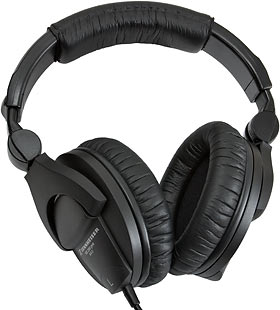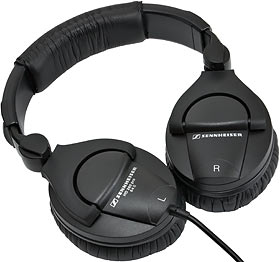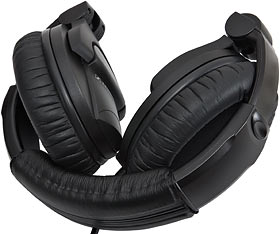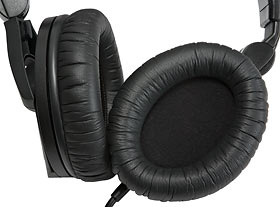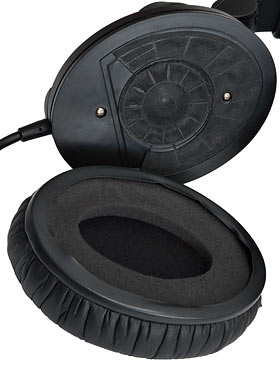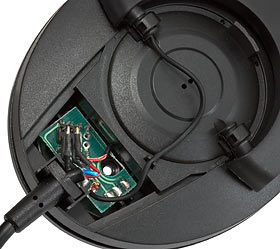
Sennheiser HD 280 Pro headphones
Review date: September 14, 2004.Last modified 03-Dec-2011.
The best headphones in the world are all "open".
That is, their little sound-making drivers are suspended in space close to the ears, surrounded by an ear-cup that generally plays some part in the sound of the headphone, but is basically just an open framework to hold the driver in the right place and protect it from damage.
You could take the drivers out of a lot of open headphones and suspend them next to your ears on a piece of coat-hanger wire, and you'd still get much the same sound.
Some open headphones are really obviously open - Sony's sci-fi MDRF1s are a standout. But you can see light through the ear-cups of many open 'phones if you turn them around a bit.
Acoustically, all open ear-cups are very much the same; the only big differences between them (he said, smiling benignly at the headphone designers who're now angrily waving thick wads of technical documentation at him) are where exactly they hold the drivers relative to your ears. The idea of the open design is to make ear-cups that have pretty much no acoustic signature of their own, so you can listen to the driver by itself, not the driver plus the resonance of the chunk of plastic and metal over your ear.
As you'd expect, though, open headphones let sound in, and out. Outside noise will make it to your ears, and your music will leak out into the outside world. There's no way around this, and it makes open 'phones unsuitable for use in a lot of situations. Various workplaces, public transport, monkey-houses, and, of course, noisy computer rooms. You may have a lovely pair of Beyer DT 880s, or Sennheiser HD 650s, or Stax exotics, and that's great - but only when there's not much ambient noise, or anybody nearby who doesn't want to share the treble portion of your program material.
The solution is sealed, or closed, headphones. They, as the name suggests, put a little sealed cup over each ear, and put the driver inside. Actually, they may seal inside the ear, as is the case with Etymotic and other "canalphones", but if you want comfortable headphones that can be put on and removed in a second, you want plain old "circumaural" (around the ears) sealed headphones.
There are "supra-aural" sealed headphones, too; they've got the same basic kind of ear-cup, but it's small and the pad sits on top of the ear rather than around it. Sennheiser's HD 212 Pro and PX 200 models are good examples; one's surprisingly good, one's not so much.
And then, there's the HD 270, which I reviewed along with the 212 Pro. The HD 270 is not a good headphone. For the money, it's a downright bad headphone. I, therefore, approached the HD two-eighty with a certain amount of trepidation.
These headphones are, to give them their full name, Sennheiser's HD 280 Pro, 64 ohm version. As distinct from the HD 280-13, which is a 300 ohm version of the same thing. The basic model's lower impedance is, for most users, better; it means headphone outputs that can't manage a whole lot of voltage will probably still be able to drive the 'phones to impressive volume. For weedy portable players you often really want 32 ohm 'phones, but sealed phones mean you have less outside noise to compete with, so 64'll do.
The HD 280 Pro sells for about $US100 (versus less than $US70 for the worth-maybe-$US15 HD 270s). They aren't quite your ISO Standard Modern Circumaural Sealed Headphones, but they've got all of the usual features. A cable that enters at only one side (so they won't catch on your chin when you take them off), softly padded headband and ear-cups, a 1/8th inch plug with a 1/4 inch adapter (of the screw-on type, so you shouldn't be able to lose it), and enough adjustability to suit most people's heads.
My head's not particularly bulbous, but I only need to extend the HD 280s' adjustable headband by two clicks on each side to make them fit; there are 12 clicks available, giving a total of about four centimetres of extra headband length on each side. So if your head's really big, these 'phones should have you covered. If it's really small, I recommend you try before you buy.
Comfort-wise, these are as good as any circumaural sealed 'phones I've used. Which is to say, they don't float on your ears like fluffy clouds, but I nonetheless don't mind wearing them for hours on end (unlike certain ear-squishing Beyers I could mention).
The 280s are hard to keep on your head if you pop just one ear-cup off so you can hear people talking to you, and/or look like a cool DJ. To make them stay when I did that, I had to yank the removed ear-cup down to its maximum size setting. The 280s' high-pressure headband also means that these headphones may try to block your carotid arteries if you take them off your head completely and wear them around your neck. So maybe you shouldn't do that.
One other slight comfort-reducer is that the HD 280 cable is a retro curly cord, with a minimally-stretched length of about a metre and a half, and a useless twanging maximum length of about three metres. If you're right next to whatever you're listening to, curly cords are pretty cool, as long as you can flop them across your lap and don't need to leave the whole thing hanging from your left ear. If you're listening at a distance, though, you'll have to get an extension cord.
One advantage of the curly cord is that it's minimally microphonic - tapping or scraping all but the very end of the curly portion doesn't result in much sound being conducted up the foot or so of straight cable that feeds the HD 280s' left ear-cup. This is more important for sealed headphones than for open ones, because the sealed design emphasises microphonic effects - try plugging your ears with your index fingers and then rubbing the backs of those fingers with your middle fingers to see what I'm talking about.
Unlike most circumaural headphones, the 280 Pros have two-way hinges on their ear-cups. This means pretty much nothing when you're wearing them, but when you want to pack them away, hang them up or transport them...
...you can fold them flat...
...or tuck them up like this. The tucked-up position makes it difficult for random objects to stab the soft parts of the ear-cups.
Articulation aside, the ear-cups are pretty ordinary...
...with the usual foam-filled cushions covered with pseudo-leather.
Most decent headphones let you replace their ear and headband cushions, and that's the case for the 280s; it's quite easy to slip the pads off the ear-cups...
...though it may take a little practice to get 'em back on again. The headband cushion should be less tricky; it's retained with a Zip-Loc sort of fastener.
There's another reason why you might want to remove the cushions, though. See the two little silver screws in the above picture? Remove them, and the back of the ear-cup comes off...
...which lets you get at the point where the cable plugs in to the left ear-cup. So you can replace the cable without having to do any soldering of minuscule wires.
This is not nearly as good as the setup used by some more expensive headphones, including several pricier Sennheisers, where the cable plugs in via some kind of stereo mini-jack. That arrangement makes it very easy to replace the cable, and it also protects the headphones from damage if the cable pulls taut for some reason. The little plug just pops out.
A fiddly internal plug like this, though, still beats the heck out of the traditional hard-wired system, where you can't replace a cable without electrical microsurgery.
The plug setup, by the way, also apparently makes it possible for a "Sennheiser service partner" to convert the HD 280s into a headset, by changing the cable and replacing the left ear-cup cover with one that supports a boom mic.
Listening
The HD 280 Pros are billed as being "designed for professional monitoring applications". There are tons of really awful headphones out there that're described with some combination of the words "Pro Studio DJ Digital Hi-Fi Reference" in front of the word "Monitor", but Sennheiser actually mean something by it.
Monitor headphones, like monitor loudspeakers, are meant to have flat, uncoloured, un-exaggerated response across a wide frequency range. They're not meant to sound "sweet" or "bassy"; they're just meant to deliver the input signal cleanly to your ears.
This isn't the philosophy of most sealed headphones. It's easy to make a sealed 'phone with a lot of bass, so that's what a lot of manufacturers do - including Sennheiser, with some of their models. The HD 280 Pros, though, don't have phat bass.
In the manual (available in PDF format here), Sennheiser quote the HD 280 frequency response as being from a perfectly adequate 25kHz to a tooth-loosening 8Hz - but those are the minus ten decibel (dB) points, which aren't actually very informative. Neither is their frequency response plot, which is pleasingly (some might say suspiciously...) flat, but which only extends down to 90Hz at the bass end.
The normally accepted limits of frequency response are the points where the graph dips 3dB below the zero dB line, never to return. Sennheiser would appear to prefer you not ask about that.
But have no fear; HeadRoom, who kindly supplied my review HD 280s, have checked. They reckon that the HD 280s' bass response is already some 5dB down at 110Hz, dribbling down to -10dB at about 50Hz.
This actually isn't that bad, though. Yes, this response plot looks a lot more mountain-rangey than Sennheiser's don't-worry-your-pretty-head-about-it marketing graph, but it actually does qualify these headphones as decent mid-priced monitors; there's a bit of a hump around 350Hz, but the rest of the midrange up to 2kHz is nice and flat, and the wiggly-worm stuff above that is on par for cheap-ish headphones in general and sealed 'phones in particular. Monitors often sacrifice some bass for overall accuracy; if you want the bass back and you're not listening at high volume, you can use equalisation.
HeadRoom's isolation graph - showing how effective the headphones' sealing is - is also worth a look. Sennheiser claim, somewhat implausibly, that these headphones offer 32dB of isolation. That would put these quite comfortable headphones almost in the same class as things like the goodbye-outside-world Etymotic earphones, which most people (including me) find much less comfortable, and which are also quite a lot more expensive.
Look at the HeadRoom graph, though, and you can see that the HD 280s do indeed manage better than 32dB isolation here and there, but only here and there - "here" being somewhere around 3000Hz, and "there" being maybe 4700Hz. And, like all conventional headphones, their bass isolation is lousy; everything below about 400Hz gets right through. The Etymotics are clearly much, much better.
That said, though, the 280s do have good isolation. If you're trying to block out low rumbling background noise then they're not much use, but for midrange-to-treble rushing noises - very much including typical computer room and office noise - they're excellent, considering their price and comfort level.
So, I hear you ask, what do they actually sound like?
Well, as I expected, they're not as good as a decent open headphone. My everyday 'phones are Sennheiser's not-especially-well-regarded HD 590s (I got 'em cheap on eBay from Germany, before people started sending me headphones for free...), and the difference between those open-backed headphones and the HD 280s is very clear.
The 590s are quite a bit more comfortable, of course, since they don't need to seal against your ears, but they also have obviously superior bass. And they have more... space. Clarity. Pompatus.
I could rabbit on further, but I'm pretty sure that apart from the bass response difference, and some high frequency clarity as well, the HD 280s fall short because of those unavoidable sealed-headphone resonance problems. I've heard far, far worse sealed headphones - like the poor old HD 270s, for instance - but midrange resonance just won't go away in sealed headphones, and it inescapably masks some detail.
But, and it's a big but, the HD 280s do not sound bad. In my opinion, anyway. I'm sure some people think they're terrible, unlistenable, ghastly. If these were open headphones, I'd recommend you try something else. There are definitely better sounding about-$US100 'phones out there.
But the 280s are sealed, and that can be a big plus.
I listened to my usual audiophile-onanism reference tracks, I listened to some completely stupid things, I played games and watched movies, and at no point did I find the HD 280s annoying. And, unlike the 590s and every other open headphone out there, I could wear the 280s in my fan-filled computer room and listen to things at quite low volume without being annoyed by fan noise leaking through.
When wearing open headphones, I can drown out the racket of my computer room by winding my 'phones up to a continuous level around 70 to 75dBA, if my sound level meter poked into the ear-cups can be believed. This shouldn't be harmful, but it can still be fatiguing, especially if you're listening to certain program material. If you're trying to cope with more noise, or listening to music with quiet passages that you don't want to hear noise through, then you'll need more volume to block it out with open headphones. And, gods of this earth notwithstanding, winding your music up to or beyond the volume of a nearby garbage truck, chain saw or pneumatic drill may leave you unable to enjoy music any more. It's definitely better to block the outside racket than to try to out-shout it.
Pricing fun
These headphones are about a hundred US bucks from HeadRoom. HeadRoom, as usual, are about as cheap as non-rip-off dealers get; feel free to shop around, but unless you're outside the USA, you shouldn't expect to save much, once you factor in shipping.
HeadRoom are nice people, and know their stuff; I'd say that about them even if they didn't keep sending me free toys. US shoppers will definitely do well to buy from them.
But what if, like me, you're in Australia - but, unlike me, you don't get these things for free?
Well, depending on which way the exchange rate's swinging when you read this, the HD 280s' US price is likely to translate into less than $AU150. Take into account importing expenses, local warranty support and so on, and a local price of $AU200 would be eminently justifiable. $AU250 would count as mild gouging.
Regrettably, the local delivered price for HD 280s is actually almost $AU300. That's what Aus PC Market charge for them, and you won't find 'em significantly cheaper anywhere in this country, because the local distributor requires all local resellers to toe the line on list prices, or receive no more stock to sell. They don't do this for all locally available Sennheiser headphones, but they do it with the 280s.
UPDATE: As of 2008, Aus PC Market are selling HD 280 Pros for only $AU253 including delivery anywhere in the country. This still isn't a great price (especially now that the US dollar is worth only slightly more than the Australian dollar), but it's definitely worth mentioning.
(Aus PC Market list the headset version of the 280 too, but you'll laugh when you see the price. No wonder they haven't bothered to get any in stock. [As of 2008, they aren't selling 280 Pro headsets at all any more.])
HeadRoom ship everything via FedEx, but even if the shipping costs $US50, that still only works out at about $AU215 at the moment. [About $AU157, as of mid-2008. From here on, I'll update all of the numbers to match mid-2008 prices.]
So what are Aussies getting for their extra $AU100 or so (a bit more than that, if they buy from a dealer who'll cheaply air-mail your headphones to you from the USA)?
Well, delivery in one to two working days instead of... maybe five, tops, for FedEx.
And a local warranty, though you shouldn't expect it to cover wear and tear on things like cushions and cables, which are all you're likely to need to replace.
Hmm.
The distributors aren't making giant fortunes by jacking up prices like this; the Aussie resellers make a very healthy margin on the higher-priced Sennheisers, thank you very much. But they have to make this margin even if they'd be happy to sell the headphones for less; if they price them lower, the distributor won't give them any more to sell.
So Australians who want to support their local hi-fi store or on-line dealer or whatever, and/or reckon the local warranty's worth the money, should by all means buy things like the HD 280s locally. If you'd rather pinch some pennies and buy from overseas, though, I really can't blame you.
As I said, Australians don't pay cranked-up prices for every Sennheiser headphone. Just several.
The AusPC page I linked to above, for Sennheiser's high-end HD 650s, lists them for an imposing $AU627 delivered (it was $AU737 when this review first went up, in 2004!). HeadRoom list them for $US499 ex delivery, which is about $AU520, as I write this - but they've got one of those "e-mail us for the real price" deals going on, and their actual price is (whispers) $US150 less. Ahem.
At the more sensible end of the price scale, the excellent PX 100 portable phones sell locally for $AU82.50 delivered (down from $AU99 when this review first went up), while HeadRoom have them for $US49.99 ex delivery ($AU52 or so; up from $US39.99 when this review first went up); so the Aussie price for them is not too dreadful, considering shipping costs. The HD 212 Pro is $AU110 delivered here, $US59.99 ex delivery there (about $AU63).
But then there are the similarly priced HD 457, HD 477 and HD 497, whose Australian prices were in 2004 something like 1.8 times the US price, making them cost easily 1.5 times what they should. They're a bit cheaper now, but I think the markup remains large. It beats me.
Overall
The HD 280 Pros are decently comfortable, and seem quite sturdy despite their clever-clever ear-cup hinges, and they're somewhat repairable, if their sturdiness should fail. So they're a really good, practical, comfortable sealed 'phone for anybody who wants to listen to music, or games, or whatever, in a somewhat noisy environment. They're not the Kings Of Bass or hi-fi 'phones par excellence, but what bass they have is pleasingly undistorted, and I found it very easy to come to terms with their sonic shortcomings.
I think a lot of people will, like me, rather like the way these headphones sound. Especially if you're accustomed to cheap and nasty or gimmicky headphones, as an awful lot of people are.
HeadRoom really like the 280s, and for $US99.99 plus delivery, I'm inclined to agree with them.
At about $AU300 delivered, the 280s weren't quite as compelling. Now that they're $AU253 delivered, they're a better deal - but still not really a good one.
Still, though, if you'd like some packable, wearable, isolating, good-sounding 'phones for the office, LAN party, crèche, server room or long train trip, you could do a lot worse than check the HD 280 Pro out.
Recommended.
Review HD 580 Pros kindly provided by HeadRoom.
HeadRoom's page for the HD 280 Pro
